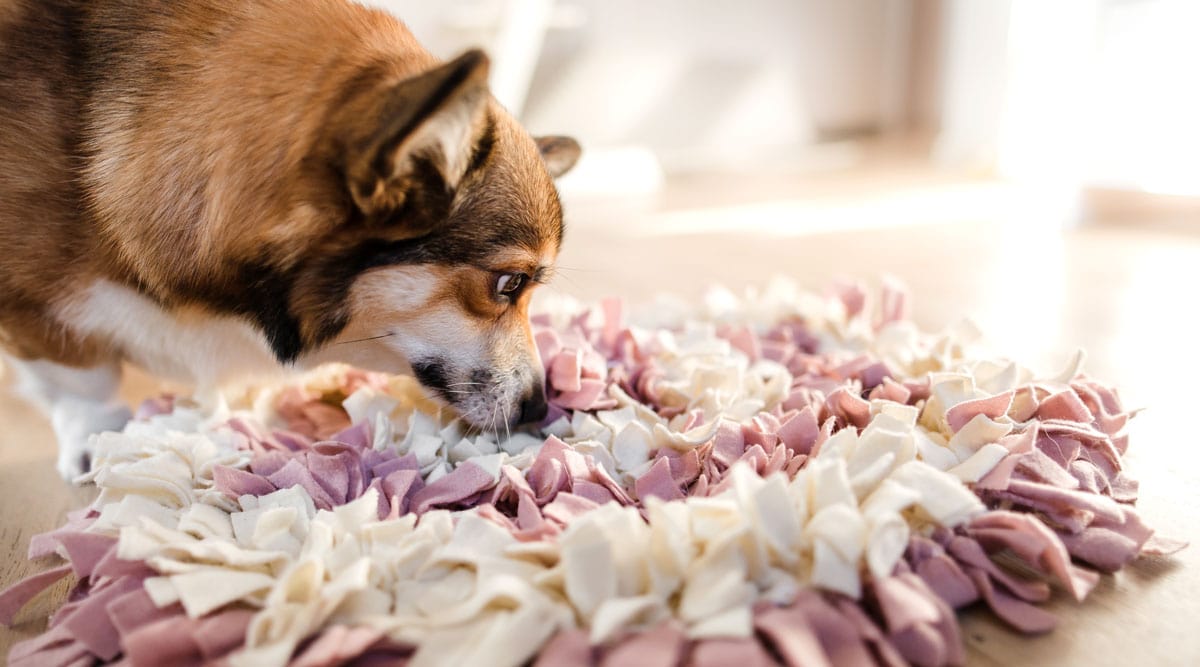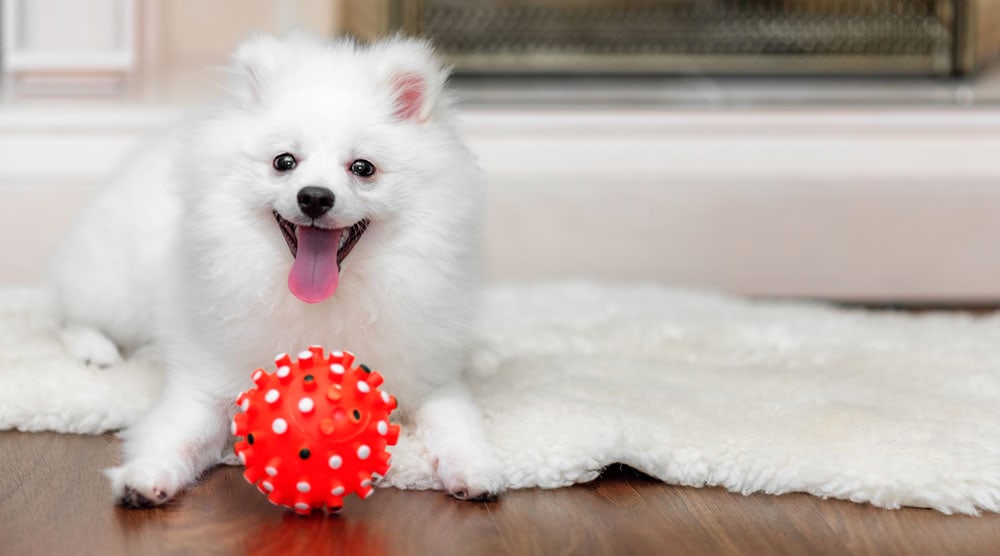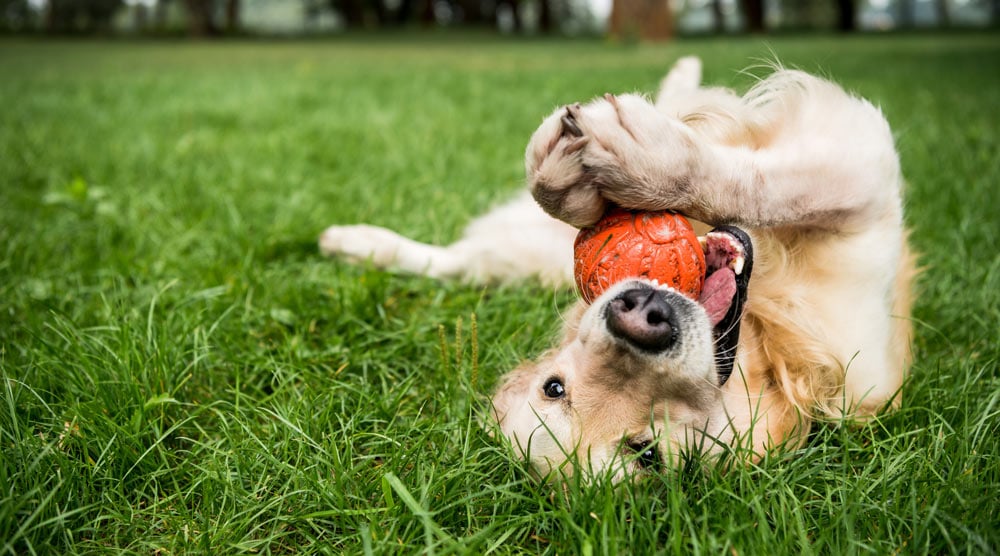Every dog owner knows that daily walks are important. However, mental stimulation for dogs is often overlooked, which can lead to boredom, unhappiness, and unwanted behaviours.
In this guide, I’ll show you seven fun ways to stimulate your dog’s mind. These simple activities can make a huge difference to your dog’s happiness and well-being.
Contents
- What is Mental Stimulation for Dogs?
- Ideas for Providing Mental Stimulation for Dogs
- 1. Always Let Your Dog Sniff and Walk At Their Own Pace
- 2. Feed Your Dog With a Puzzle Toy
- 3. Mix Up Your Walking Routes
- 4. Challenge Your Dog’s Sense of Smell With a Snuffle Mat
- 5. Make an Indoor Treat Hunt
- 6. Rotate Your Dog’s Toys (And Add More To Their Collection!)
- 7. Spend Quality Time Playing With Your Dog
What is Mental Stimulation for Dogs?
Have you ever felt bored or frustrated after spending the day alone? Or suffered from general anxiety or stress when you’ve been at home for too long?
Boredom, stress, and other negative feelings can affect dogs in a similar way, particularly when they’ve not had the chance to take part in normal canine behaviours. That’s why mental stimulation (also sometimes called mental enrichment) is so important for dogs.
Which types of activities do dogs find mentally stimulating though? Some examples include:
- Sniffing
- Exploring new areas
- Searching for food
- Chewing
- Playing games
- Playing with squeaky toys
- Interacting with humans (including getting love and affection)
- Performing mentally challenging tasks (such as puzzle feeders)
When a dog is bored, they may engage in repetitive behaviours to try and relieve the unpleasant emotions they are feeling. Dogs lacking mental stimulation are also more likely to show unwanted behaviours, such as excessive barking or destructive chewing. Not getting enough mental stimulation can even affect a dog’s sleep quality!
The bottom line is that dogs need variety and consistent mental enrichment. Without mental stimulation, they become unhappy, stressed, and frustrated.
Mental stimulation tends to get overlooked in our dog’s daily routine. As a result, owners often try and tire out their dog or through more exercise. However, this can have the opposite effect, and lead to physical overtiredness and a dog that still seems hyped even after a walk!
Rebecca Morello, Dog Trainer (IMDT, ADUK)
In contrast, fun mental stimulation has huge calming benefits for dogs. Our dogs need canine-specific stimulation too which can help prevent behaviours such as excessive barking, destruction and even reactivity.
Note: Mental stimulation is different from physical exercise. Regular walks are vital for a dog’s wellbeing, but mental stimulation is equally important.
Ideas for Providing Mental Stimulation for Dogs
1. Always Let Your Dog Sniff and Walk At Their Own Pace
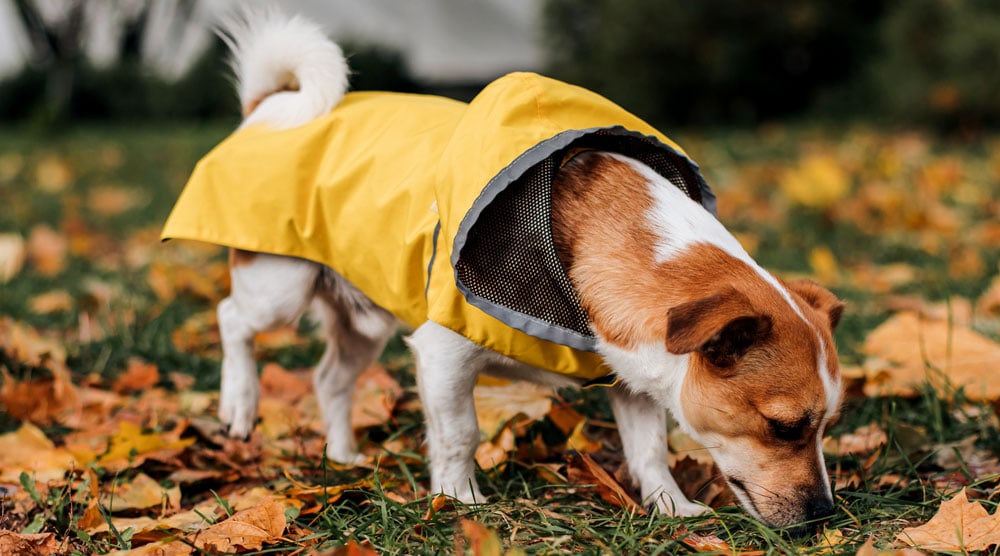
Many dog owners get frustrated when their dog seems to stop and sniff every few metres. But hurrying a dog through their walk is a common mistake that makes walking much less enriching.
It’s vital that dogs are allowed to sniff and explore at their own pace. Through scent, they can detect other animals, judge the mood or health of another dog, and learn about their surroundings. This activity provides crucial sensory input that keeps their brain active and engaged.
Additionally, being patient on a walk allows your dog to engage in their key natural behaviours. This can reduce stress and even improve the bond between you, as your dog will have a much more enjoyable and relaxing walk.
Next time you’re out on a walk, resist the urge to pull them away from their sniffing spots. Instead, be patient, let them enjoy the sensory feast, and appreciate the walk as a moment of relaxation and exploration for both of you.
2. Feed Your Dog With a Puzzle Toy
Most dog owners tend to put their pet’s food into a bowl at meal times. There’s nothing wrong with this, but it misses out on the opportunity for extra mental stimulation.
Instead, puzzle toys are designed to challenge and stimulate your dog’s brain when eating. You place your dog’s kibble or treats inside the toy, and then your dog has to figure out how to get the food out.
There are many puzzle toys on the market. These range in difficulty, so I recommend choosing a simple option to begin with. It’s very important that the toy is challenging but not frustrating for your pet. As your dog gets more experienced, you can try increasing the difficulty.
Alternatively, you can scatter feed your dog’s meal. Rather than using a puzzle feeder, simply scatter your dog’s kibble on the floor so your pet needs to search for it.
Related Article: Which Are The Best Puzzle Toys for Dogs?
3. Mix Up Your Walking Routes
Mixing up your walking routes is a simple way to provide mental stimulation for your dog. Different routes introduce your pet to new smells, sights, and sounds, which activate their brain and keep them engaged.
To put this into action, try exploring different neighborhoods, parks, or hiking trails. Even a small variation in your route – such as walking your normal loop in the opposite direction – can make things more interesting for your dog.
Of course, always make sure these environments are safe and dog-friendly. Remember to keep your dog on a leash during these new adventures, and let them explore and sniff at their own pace.
I also don’t recommend this tip if your dog is nervous on walks or is newly adopted. In these situations, new environments might cause unnecessary stress.
4. Challenge Your Dog’s Sense of Smell With a Snuffle Mat

Snuffle mats are designed to make the dog “forage” for their food. They are often made with fleece strips on a rubber base, but can also contain pouches and other accessories to hide treats or kibble.
As your dog sniffs the mat, they’ll have to find their tasty rewards. It’s not just a fun game, but also a great way to slow down dogs who eat their food too quickly.
The reason snuffle mats are so effective for mental stimulation is that they encourage your dog to use their natural foraging instincts. As we mentioned earlier, any activity that involves natural canine behaviours is likely to be enriching. Snuffle mats can also help reduce stress and anxiety, as focusing on the task can be calming for dogs.
5. Make an Indoor Treat Hunt
An indoor treat hunt is a great way to engage your dog’s sense of smell and mental problem-solving skills. The reward at the end also makes this a game that most dogs love!
Start by choosing small, smelly treats that your dog enjoys eating. While your dog is in a separate room or distracted, start hiding these treats in various locations around the house.
To begin with, it’s best to use easy hiding spots while your dog learns the game. You may also need to guide them to the treats until they understand that there are rewards to be found.
Over time, you can progress to more challenging locations. Just make sure you choose safe locations where the dog won’t risk knocking over objects or ingesting non-edible items.
6. Rotate Your Dog’s Toys (And Add More To Their Collection!)
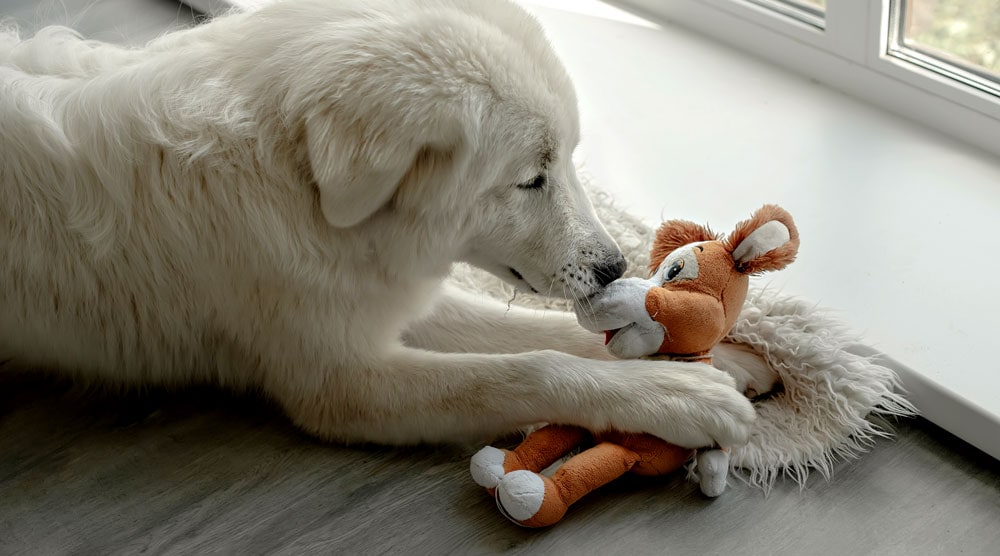
Just like kids, dogs can get bored with their toys. While buying new ones is a temporary fix, there is a cheaper solution – rotate your pet’s toys on a regular basis!
By introducing just a few toys at a time and then swapping them for others after a few days, you create a sense of novelty that can keep your dog engaged. It can also help to put the toys away after a play session, rather than leaving them out all the time (although I recommend always leaving out 1-2 toys at least).
While rotating toys can be helpful, it’s also a good idea to add more toys to your dog’s collection. Try to get a range of toys with different textures, noises, squeakers, and sizes to keep your pet’s mind active.
Note: If your dog doesn’t seem to like toys, don’t panic! Read our guide to what to do if a dog doesn’t like toys.
7. Spend Quality Time Playing With Your Dog
Giving your dog attention through playing games is one of the best forms of mental stimulation. Your dog gets to spend time with your, which they will love, and have their brain stimulated with fun activities.
There are many games you can play with your dog. Some great examples include:
- Tug of war (make sure to end the game before your dog gets overstimulated though). Allow the dog to do the actual pulling – your job is just to hold the toy. Don’t drag your dog around, as this can cause over-stimulation and neck injuries.
- Hide and seek with a toy. If you don’t want to give your pet too many treats, a treasure hunt with a toy can be a great alternative. You’ll need to spend time teaching your dog this game by gradually increasing the difficulty.
- Playing with squeaky toys. Squeaky toys are often much more interesting to dogs than ones that don’t make a noise.
- Training new tricks. Trick training is a great way to bond with your pet. It’s also very tiring, making it an excellent form of mental enrichment.
There’s also something called the “backpack walk”, which combines mental stimulation with a walk. It’s easier to explain in a video, so here’s a useful guide:
Related Article: Indoor Activities for Dogs
